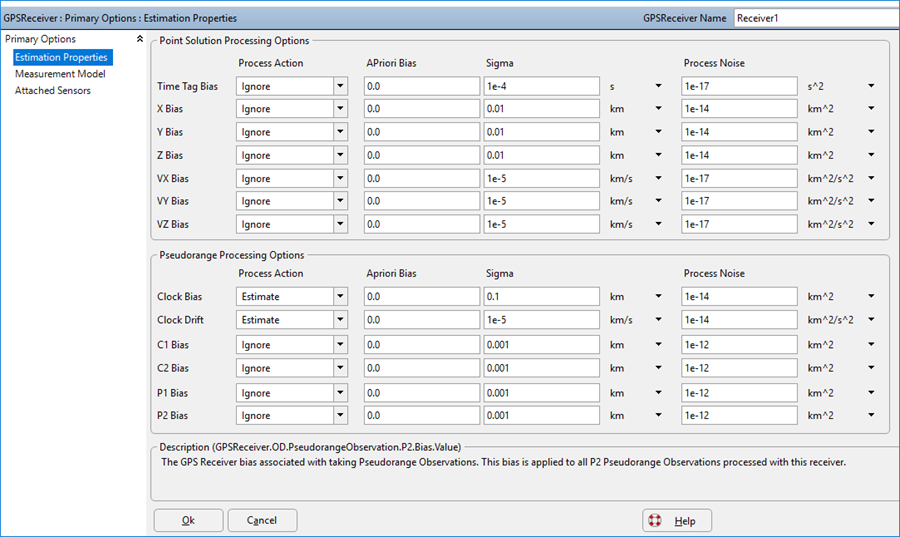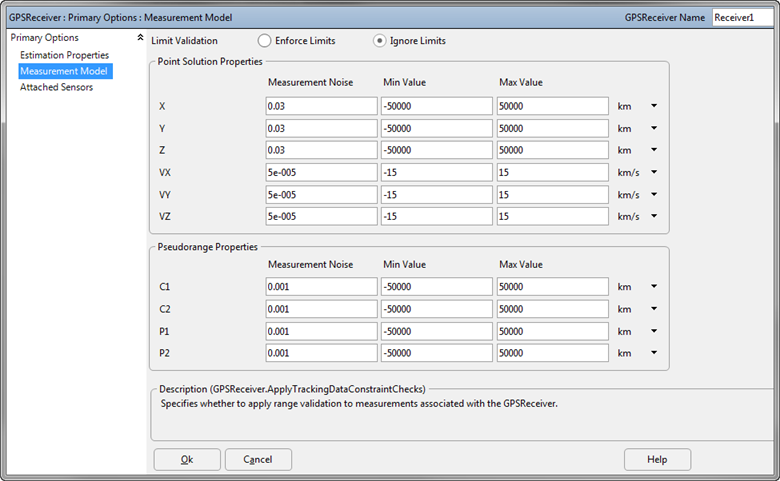You can configure the Orbit Determination Properties for a GPSReceiver through FreeFlyer script or the Object Browser. There are two ways to navigate to the "Estimation Properties" page of the GPSReceiver object editor:
1.Open the desired GPSReceiver's editor 2.Highlight the desired GPSReceiver on the "Objects to Process" page of a Kalman Filter, Square Root Information Filter, Unscented Kalman Filter, or Batch Least Squares object editor and click the "Modify GPSReceiver Estimation Options" button |
From this page, you can configure any of these options:
•The GPSReceiver properties that you want to ignore, estimate, or consider oIgnore: Leave the property out of the estimated state. oEstimate: Include the property in the estimated state and allow the estimator to update its value. oConsider: Include the property in the estimated state, but do NOT allow the estimator to update its value. This means that the property gets included in the covariance, but is not directly estimated. •The A Priori Bias, Sigma, and Process Noise Rate for each of the properties |
Different GPS receiver properties can be estimated depending on whether you are processing Point Solution observations or Pseudorange observations.

GPS Receiver OD Properties
To define the GPSReceiver properties that you want to estimate or consider via FreeForm script, you will access the GPSReceiver's OD properties, as shown in the example below:
Alias receiver = (Spacecraft1.Receivers[0] AsType GPSReceiver); // This alias is used to shorten the script examples below
// Point Solution Observation Receiver Properties receiver.OD.PointSolutionObservation.TimeTagBias.ProcessAction = 0; receiver.OD.PointSolutionObservation.X.Bias.ProcessAction = 0; receiver.OD.PointSolutionObservation.Y.Bias.ProcessAction = 0; receiver.OD.PointSolutionObservation.Z.Bias.ProcessAction = 0; receiver.OD.PointSolutionObservation.VX.Bias.ProcessAction = 0; receiver.OD.PointSolutionObservation.VY.Bias.ProcessAction = 0; receiver.OD.PointSolutionObservation.VZ.Bias.ProcessAction = 0;
// Pseudorange Observation Receiver Properties // Properties to Estimate receiver.OD.PseudorangeObservation.ClockBias.ProcessAction = 1; receiver.OD.PseudorangeObservation.ClockDrift.ProcessAction = 1;
// Properties to Ignore receiver.OD.PseudorangeObservation.C1.Bias.ProcessAction = 0; receiver.OD.PseudorangeObservation.C2.Bias.ProcessAction = 0; receiver.OD.PseudorangeObservation.P1.Bias.ProcessAction = 0; receiver.OD.PseudorangeObservation.P2.Bias.ProcessAction = 0; |
Once the GPS Receiver has been configured, it can be used as an observing object or object being observed when simulating tracking data or including tracking data in an estimation process.
GPS Receiver Measurement Model
When the observer is a GPS Receiver, you can configure the measurement model (including the noise, maximum, and minimum values) for each of the following measurement types:
•Point Solution oX oY oZ oVX oVY oVZ •Pseudorange oC1 oC2 oP1 oP2 |
You can configure these values through the Object Browser by double-clicking on the desired Spacecraft and navigating to the "Receivers" page under the Orbit Determination section, highlighting the desired Receiver and selecting "Edit Receiver". The panel that pops up is shown in the image below:

The GPS Receiver Measurement Model Editor
You can also configure these options through FreeFlyer script, by accessing various properties of the GPS Receiver object:
Alias receiver = (Spacecraft1.Receivers[0] AsType GPSReceiver); // This alias is used to shorten the script examples below
// Point Solution Measurement Model receiver.OD.PointSolutionObservation.X.Noise = 0.03; receiver.OD.PointSolutionObservation.Y.Noise = 0.03; receiver.OD.PointSolutionObservation.Z.Noise = 0.03; receiver.OD.PointSolutionObservation.VX.Noise = 5E-005; receiver.OD.PointSolutionObservation.VY.Noise = 5E-005; receiver.OD.PointSolutionObservation.VZ.Noise = 5E-005;
// Pseudorange Measurement Model receiver.OD.PseudorangeObservation.C1.Noise = 0.001; receiver.OD.PseudorangeObservation.C2.Noise = 0.001; receiver.OD.PseudorangeObservation.P1.Noise = 0.001; receiver.OD.PseudorangeObservation.P2.Noise = 0.001; |
Attached Sensors
The Attached Sensors page of the GPS Receiver object editor allows you to indicate any Sensors that will be attached to the receiver for simulating or processing OD tracking data. The Sensor's X, Y, and Z position properties will be used to model an offset from the origin of the Spacecraft body coordinate system (BCS) when modeling measurements. You can also specify the Sensors to attach or detach via FreeFlyer script:
receiver.Attach(Spacecraft1.Sensors[0]);
receiver.Detach(Spacecraft1.Sensors[0]); |
See Also
•GPSReceiver Properties and Methods •ReceiverODProperties Properties and Methods |